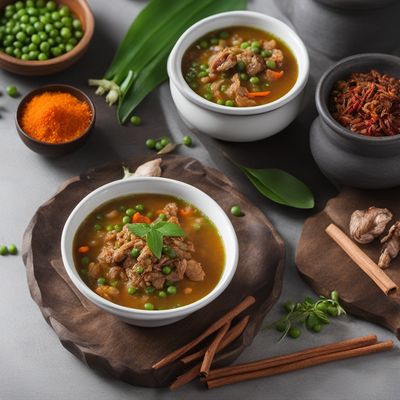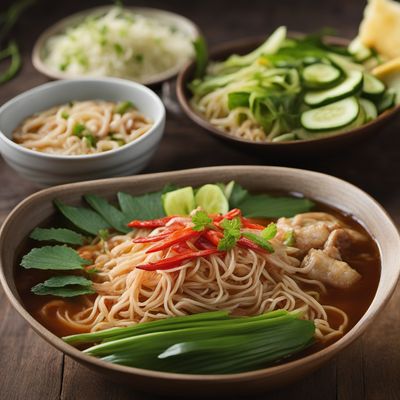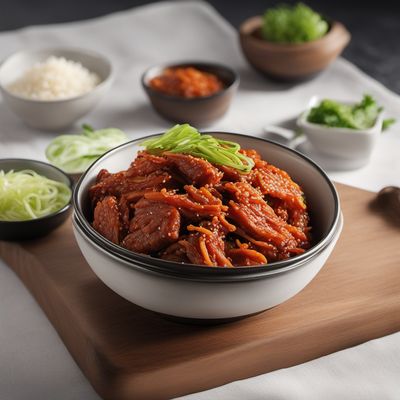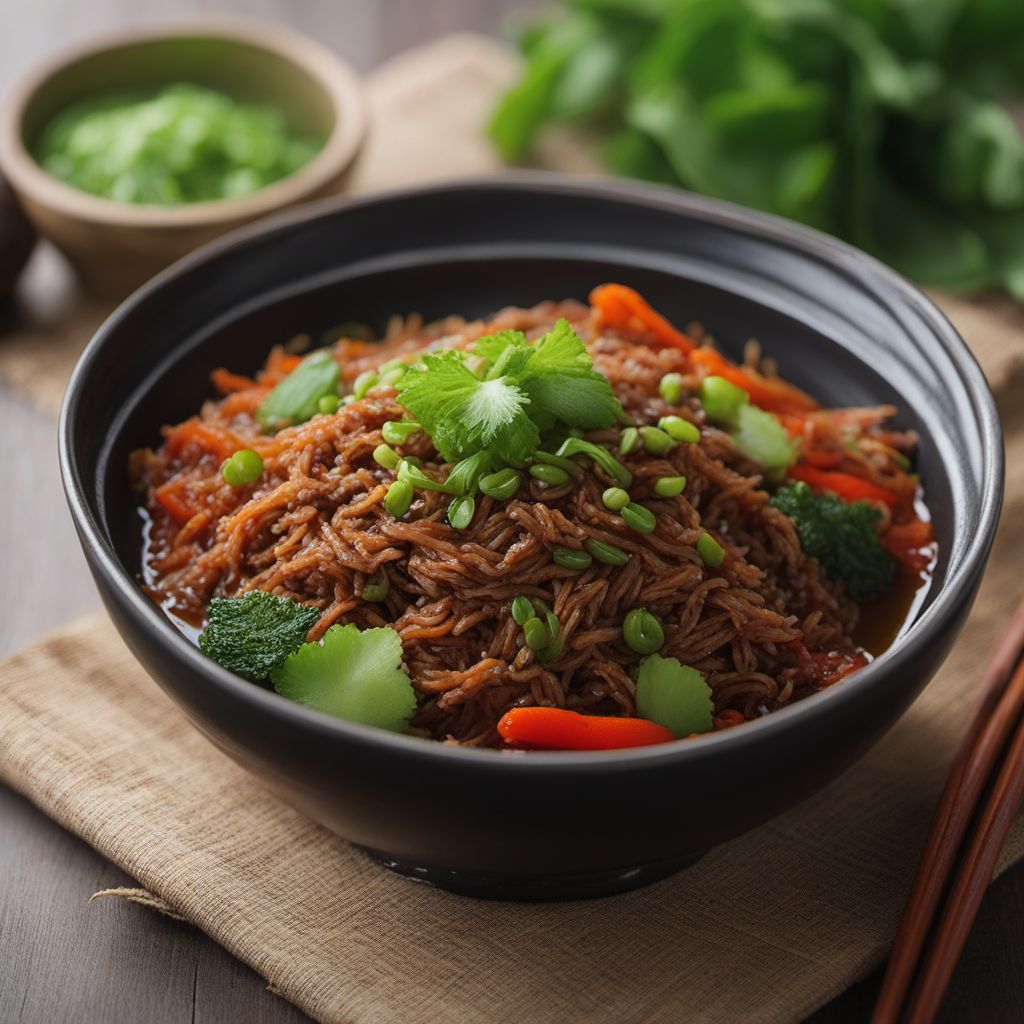
Recipe
Korean Chinese Style Nasi Kerabu
Seoul-ful Blue Rice Bowl: A Fusion of Korean and Chinese Flavors
4.7 out of 5
Indulge in the vibrant flavors of Korean Chinese cuisine with this unique twist on the classic Malaysian dish, Nasi Kerabu. This fusion recipe combines the fragrant blue rice, fresh herbs, and zesty sambal of Nasi Kerabu with the bold and savory flavors of Korean Chinese cuisine.
Metadata
Preparation time
30 minutes
Cooking time
20 minutes
Total time
50 minutes
Yields
4 servings
Preparation difficulty
Medium
Suitable for
Omnivore, Gluten-free, Dairy-free, Nut-free, Low sugar
Allergens
Soy, Shellfish (if using oyster sauce)
Not suitable for
Vegan, Vegetarian, Paleo, Keto, High sodium
Ingredients
In this Korean Chinese adaptation of Nasi Kerabu, we incorporate elements from Korean and Chinese cuisines to create a unique fusion dish. The blue rice remains a key component, but we introduce Korean Chinese spices and stir-fried vegetables to add depth and complexity to the dish. The sambal sauce is also modified to include Korean Chinese flavors, resulting in a harmonious blend of tastes from both cuisines. We alse have the original recipe for Nasi kerabu, so you can check it out.
-
2 cups (400g) jasmine rice 2 cups (400g) jasmine rice
-
2 cups (470ml) water 2 cups (470ml) water
-
1 tablespoon butterfly pea flower powder 1 tablespoon butterfly pea flower powder
-
1 tablespoon vegetable oil 1 tablespoon vegetable oil
-
1 onion, thinly sliced 1 onion, thinly sliced
-
2 cloves garlic, minced 2 cloves garlic, minced
-
1 carrot, julienned 1 carrot, julienned
-
1 bell pepper, thinly sliced 1 bell pepper, thinly sliced
-
1 cup (150g) cabbage, shredded 1 cup (150g) cabbage, shredded
-
300g marinated beef, chicken, or pork (bulgogi-style marinade works well) 300g marinated beef, chicken, or pork (bulgogi-style marinade works well)
-
2 tablespoons soy sauce 2 tablespoons soy sauce
-
1 tablespoon oyster sauce 1 tablespoon oyster sauce
-
1 tablespoon gochujang (Korean chili paste) 1 tablespoon gochujang (Korean chili paste)
-
1 tablespoon sesame oil 1 tablespoon sesame oil
-
1 tablespoon rice vinegar 1 tablespoon rice vinegar
-
1 tablespoon sugar 1 tablespoon sugar
-
Salt and pepper to taste Salt and pepper to taste
-
Sambal sauce, to serve Sambal sauce, to serve
-
Fresh herbs (such as cilantro and mint), for garnish Fresh herbs (such as cilantro and mint), for garnish
Nutrition
- Calories (kcal / KJ): 450 kcal / 1884 KJ
- Fat (total, saturated): 12g, 3g
- Carbohydrates (total, sugars): 65g, 5g
- Protein: 22g
- Fiber: 4g
- Salt: 2g
Preparation
-
1.Rinse the jasmine rice until the water runs clear. In a pot, combine the rice, water, and butterfly pea flower powder. Cook the rice according to the package instructions until it is fluffy and the blue color is vibrant.
-
2.Heat vegetable oil in a large pan or wok over medium heat. Add the sliced onion and minced garlic, and sauté until fragrant and translucent.
-
3.Add the julienned carrot, sliced bell pepper, and shredded cabbage to the pan. Stir-fry for 3-4 minutes until the vegetables are slightly tender but still crisp.
-
4.Push the vegetables to one side of the pan and add the marinated meat to the other side. Cook the meat until it is browned and cooked through.
-
5.In a small bowl, whisk together soy sauce, oyster sauce, gochujang, sesame oil, rice vinegar, sugar, salt, and pepper. Pour the sauce over the meat and vegetables, and stir to coat everything evenly. Cook for an additional 2-3 minutes until the flavors meld together.
-
6.To serve, place a generous portion of blue rice on a plate. Top it with the stir-fried meat and vegetables. Drizzle with sambal sauce and garnish with fresh herbs.
Treat your ingredients with care...
- Butterfly pea flower powder — Adjust the amount of powder according to your desired intensity of blue color in the rice. You can find butterfly pea flower powder in specialty Asian grocery stores or online.
- Marinated meat — For a quick and easy option, look for pre-marinated bulgogi-style meat at your local Korean or Asian market. Alternatively, marinate thinly sliced beef, chicken, or pork in a mixture of soy sauce, sesame oil, garlic, ginger, and sugar for at least 30 minutes before cooking.
Tips & Tricks
- If you can't find butterfly pea flower powder, you can substitute it with a few drops of blue food coloring.
- Customize the stir-fried vegetables by adding other Korean Chinese favorites like mushrooms, bean sprouts, or bok choy.
- Adjust the spiciness of the sambal sauce by adding more or less gochujang according to your preference.
- For an extra burst of flavor, squeeze some fresh lime juice over the dish before serving.
- Feel free to experiment with different types of marinated meat, such as spicy Korean bulgogi or sweet and sour Chinese-style pork.
Serving advice
Serve Korean Chinese Style Nasi Kerabu as a complete meal on its own. However, you can also pair it with a side of kimchi or pickled vegetables to add more depth to the flavors.
Presentation advice
To create an appealing presentation, arrange the blue rice in a mound at the center of the plate. Surround it with the stir-fried meat and vegetables, creating a colorful and vibrant display. Garnish with fresh herbs for a pop of green.
More recipes...
More Malaysian cuisine dishes » Browse all
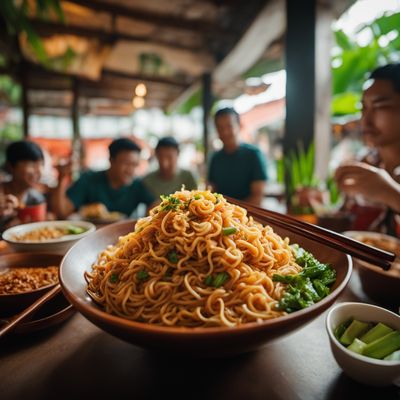
Mee bandung
Spicy Noodles
Mee bandung is a popular Malay noodle dish that is commonly found in Malaysia and Singapore.

Big pau
Big Pau
Big pau is a type of Chinese steamed bun filled with meat or vegetables.

Lemang
Bamboo-cooked glutinous rice
Lemang is a traditional Malaysian dish made from glutinous rice and coconut milk, cooked in bamboo tubes over an open fire. It is often served...
